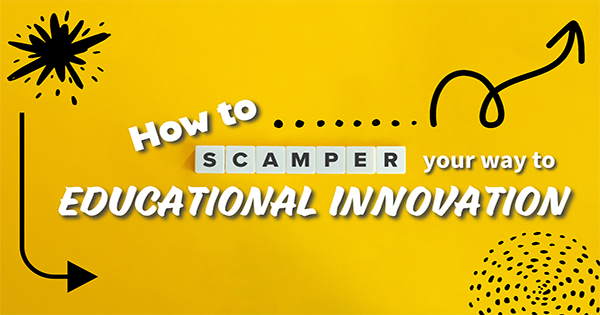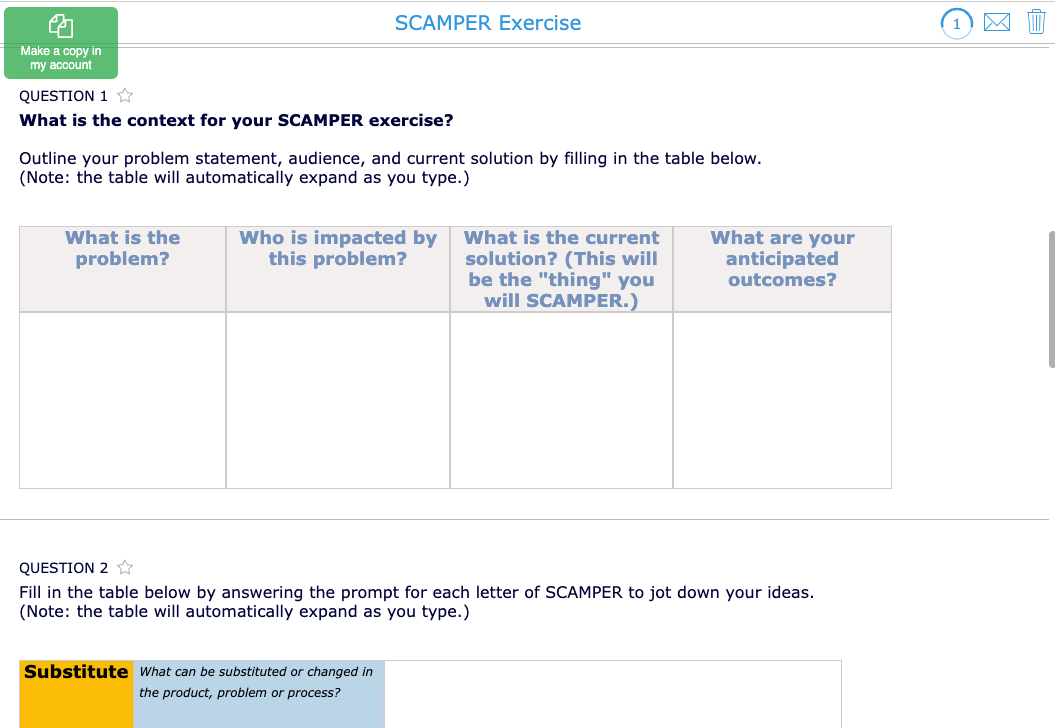How Teachers Can SCAMPER Their Way To Educational Innovation
 Kate Baker —
Kate Baker —
Imagine a place where challenges are opportunities in disguise, where empathy fuels innovation, and where learning takes on a whole new dimension. In the ever-evolving educational landscape, human-centered design and design thinking are proving to be invaluable tools for educators. By placing teachers’ and students’ needs, interests, and experiences at the core of problem-solving, educators can craft innovative strategies that resonate deeply with their learning environments. In short, human-centered design and design thinking empowers teachers for innovation with not only innovative teaching approaches and creative lesson planning, but also for large scale teacher-driven innovations. Through design thinking exercises, such as SCAMPER, teachers can analyze and redefine the issues they face, fostering a culture of empathy, collaboration, and innovation.
In this blog post, we’ll review human-centered design and design thinking to explore how these dynamic approaches can redefine your teaching and ignite your students’ enthusiasm for learning, providing a toolkit for systematically addressing issues in the classroom and beyond.
In this post we will answer…
- What is Human-Centered Design?
- What is the design thinking process?
- How can HCD and design thinking be a teacher innovation toolkit?
- How can educators use SCAMPER and BookWidgets to transform their lessons?
- What are some more design thinking exercises for teachers?

What is Human Centered Design?
Human-Centered Design (HCD) is a problem-solving approach that places the needs, preferences, and experiences of users at the forefront of the design process. It focuses on gaining a deep understanding of the people for whom a product or service is intended, empathizing with their challenges and aspirations. HCD then leverages this empathy to create innovative solutions that are tailored to meet users’ specific requirements, resulting in products and experiences that are more intuitive, user-friendly, and effective.
Human-Centered Design (HCD) originated in the fields of industrial design and ergonomics in the mid-20th century. Its roots can be traced back to the design philosophy of focusing on users and their needs, which became more pronounced during the 1960s and 1970s. One influential figure in the development of HCD is Herbert A. Simon, whose 1969 book “The Sciences of the Artificial” laid groundwork for the design thinking process. Additionally, the terms “user-centered design” and “user experience” were popularized in the 1980s by Donald Norman, a cognitive scientist and usability engineer who also worked for Apple in the mid-90s. He emphasized the importance of designing with the user’s experience (UX) in mind in his book “The Design of Everyday Things”, which remains a UX bible to this day.
The UX ideology further evolved into a broader, multidisciplinary approach, encompassing not just product design but also services, processes, and systems. The idea of involving users in the design process and focusing on empathy to understand their needs and wants became central to this design philosophy. In recent years, human-centered design has been applied across various fields, including education, healthcare, technology, and social innovation, transforming the way problems are approached and solutions are crafted.
Curious about Human Centered Design? Check out this BookWidgets’ Split Worksheet activity that provides additional information.
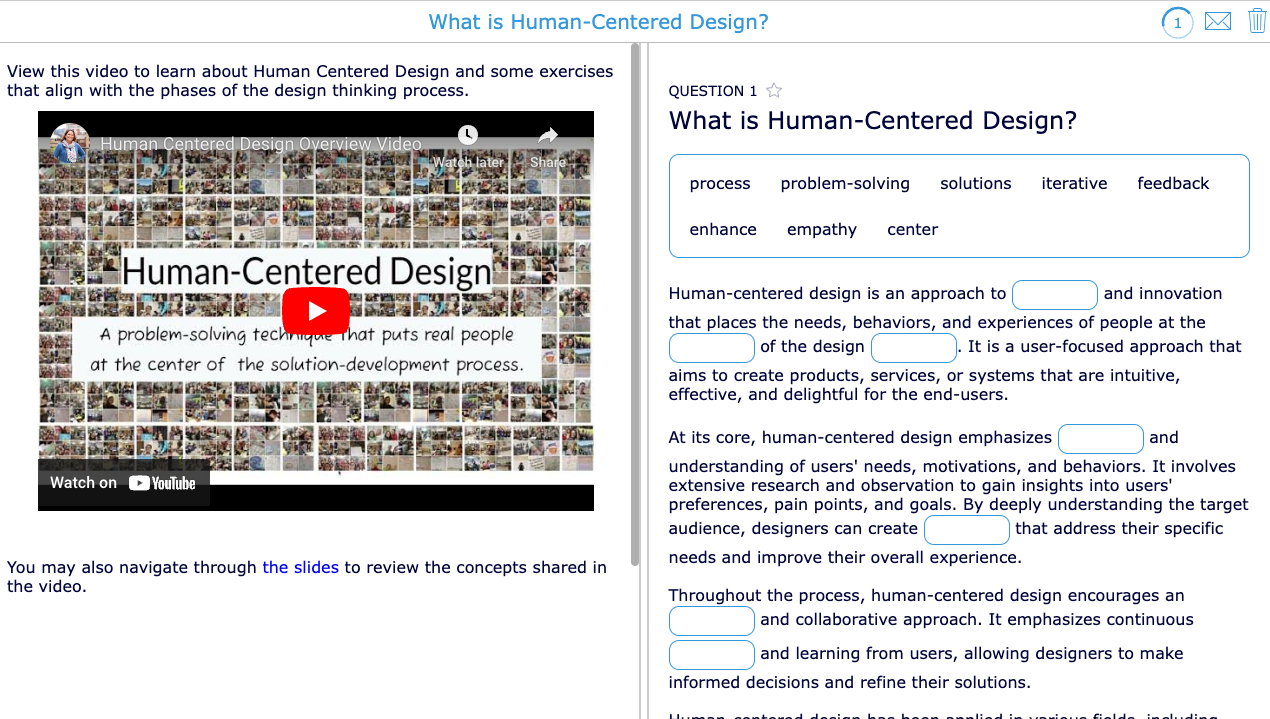

What is the design-thinking process?
The design thinking process is a human-centered approach to innovation. The process integrates the needs of people, the possibilities of technology, and the requirements for success. It is often represented through the following five iterative stages:
- Empathize: This phase involves understanding the needs, thoughts, emotions, and motivations of the people you are designing for. Through observations, interviews, and immersive experiences, you gain insights into users’ needs and challenges.
- Define: In this stage, you synthesize the gathered information to define the core problems and challenges you are aiming to solve. The goal is to articulate the users’ needs and insights, framing them in a human-centered way.
- Ideate: During this phase, you brainstorm and explore a wide variety of creative solutions. The emphasis is on generating a large quantity of ideas without immediate judgment, encouraging innovative thinking and collaboration.
- Prototype: This stage involves creating low-fidelity representations of the concepts, which may include physical models, digital mockups, or simple sketches. Prototypes are a way to visualize and test ideas quickly, allowing for iterative refinement.
- Test: In this final stage, you gather feedback by testing the prototypes with users. Observing their interactions and listening to their feedback helps in refining the concepts, making necessary adjustments, and improving the design.
The design thinking process is iterative, meaning it often requires revisiting earlier stages, refining, and retesting. This approach encourages flexibility and adaptability, making it suitable for solving complex problems across various fields, including education, healthcare, business, and technology.
Want to dive into design thinking? Check out these exercises made with BookWidgets that explore each phase of the process!
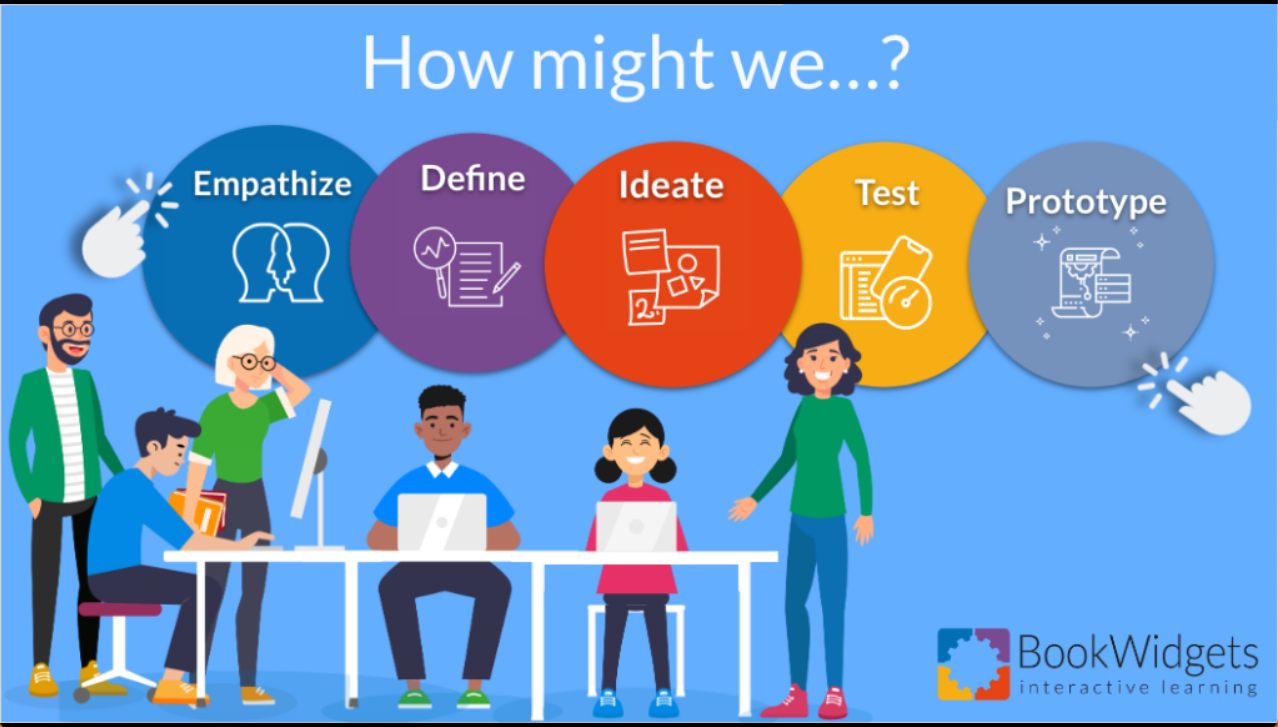
For educators, the design thinking process offers a structured methodology to identify challenges, generate creative solutions, and implement innovative strategies in the classroom, all centered around the unique needs and experiences of the students. The design thinking process is a teacher innovation tookit.

How can HCD and design thinking be a teacher innovation toolkit?
Have a lesson that isn’t going well? Having behavioral issues with a particular class? Looking for a more efficient method of scoring student work? Struggling with creating effective professional development experiences for staff? Having issues with integrating technology on a whole-school scale? Educators can apply Human-Centered Design (HCD) principles to improve the educational experience for students, teachers, and all stakeholders involved in the education system and find solutions for the problems faced everyday.
Here are some educational transformation strategies to get started with HCD as a toolkit for innovation:
 Understand Student Needs: Start by deeply understanding the needs, preferences, and challenges of students. Conduct surveys, interviews, and observations to gather insights into their learning styles, motivations, and pain points.
Understand Student Needs: Start by deeply understanding the needs, preferences, and challenges of students. Conduct surveys, interviews, and observations to gather insights into their learning styles, motivations, and pain points.
 Foster Empathy Across the Education Community: Education is inherently a community endeavor. Cultivate empathy not only for students but also for staff and all stakeholders to discern their unique needs and challenges. What tools, resources, or support are essential to ensure their success in the educational journey?
Foster Empathy Across the Education Community: Education is inherently a community endeavor. Cultivate empathy not only for students but also for staff and all stakeholders to discern their unique needs and challenges. What tools, resources, or support are essential to ensure their success in the educational journey?
 Define the Problem: Clearly define the educational problem or challenge you want to address. This problem should be framed from the perspective of the students and teachers, and it should be specific and actionable.
Define the Problem: Clearly define the educational problem or challenge you want to address. This problem should be framed from the perspective of the students and teachers, and it should be specific and actionable.
 Ideate for Solutions: Brainstorm a wide range of solutions to address the defined problem. Encourage creative thinking among educators, students, and other stakeholders. Consider both traditional and innovative approaches.
Ideate for Solutions: Brainstorm a wide range of solutions to address the defined problem. Encourage creative thinking among educators, students, and other stakeholders. Consider both traditional and innovative approaches.
 Collaborate and Promote Inclusivity: Collaborate with other educators, administrators, and parents to ensure that the designed solutions align with broader educational goals. Design educational solutions that are inclusive and accessible to all.
Collaborate and Promote Inclusivity: Collaborate with other educators, administrators, and parents to ensure that the designed solutions align with broader educational goals. Design educational solutions that are inclusive and accessible to all.
Applying Human-Centered Design to education can lead to more engaging, effective, and inclusive learning experiences. It emphasizes empathy, iterative improvement, and a focus on the needs and experiences of both students and educators.
Want to see Human Centered Design in action? Check out this example where I used various design thinking exercises and the power of BookWidgets to solve the problems my students and I faced during the 9th grade research paper unit. I was able to swap traditional paper-and-pen assignments for interactive digital lessons created with BookWidgets that adapt to individual learning paces, providing real-time feedback and personalized content.
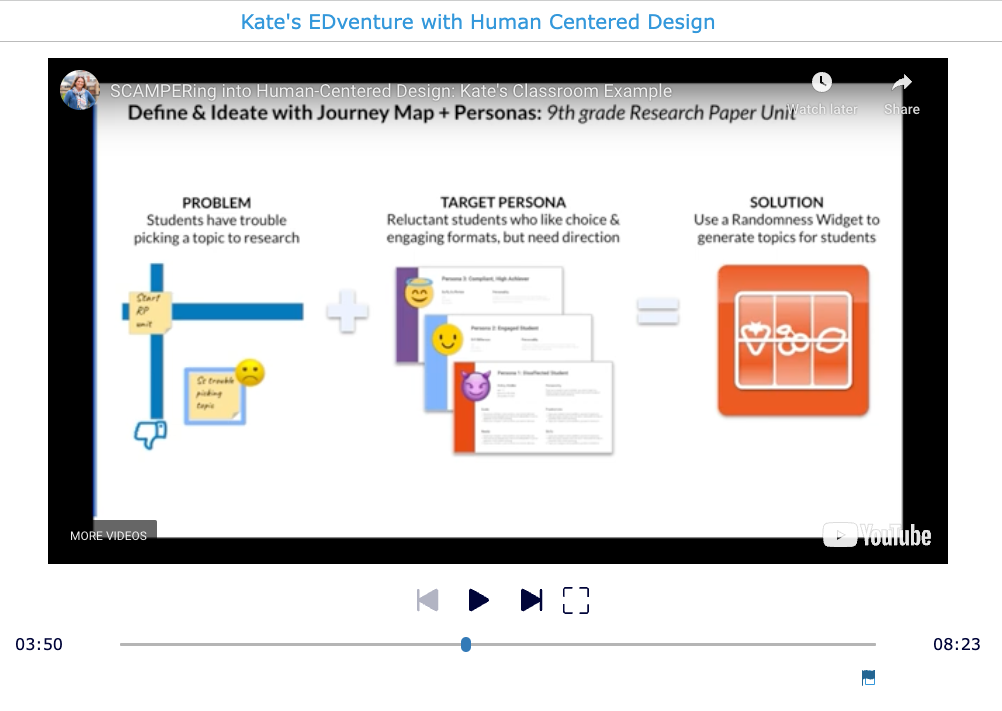
By thoughtfully applying HCD principles to the integration of technology, educators can create learning experiences that are not only more engaging but also tailored to meet the diverse needs of students. Furthermore, educators at every level of the educational system can apply HCD to address issues the entire learning community is facing.

How can educators use SCAMPER to transform lessons?
Educators have a powerful toolkit at their disposal when they seamlessly apply Human-Centered Design (HCD) principles to lesson planning while embracing innovative, design-thinking methodologies like the SCAMPER method. The SCAMPER method is a creative brainstorming technique that can be used for both the ideation and prototyping phases of human-centered, design thinking to generate new ideas and solutions by asking specific questions. Each letter in “SCAMPER” represents a different question or prompt that encourages one to think differently about a problem or situation.
SCAMPER, an acronym for Substitute, Combine, Adapt, Modify, Put to another use, Eliminate, and Rearrange or Reverse, provides a dynamic framework for reimagining teaching strategies and integrating technology in ways that resonate with students’ needs and preferences. The SCAMPER method can, for example, empower teachers to re-envision how to integrate technology, particularly leveraging the versatile capabilities of BookWidgets, into their educational content creation.
Teachers can explore ways to substitute or adapt traditional teaching materials or methods with technology-driven alternatives:
Instead of using physical flashcards, educators can opt for the digital Flash Cards widget in BookWidgets or convert a traditional paper worksheet into an interactive, auto-graded BookWidgets activity using any of the 40-widget types and 36 question-types.
For those yearning to break free from the monotony of traditional lectures, the answer lies in adapting live lectures and recording video lessons. With BookWidgets, these videos can be transformed into dynamic educational experiences through Video Quizzes. These quizzes transcend passive assessment tools by actively engaging students with auto-scored questions. This ensures that comprehension and understanding are achieved, all while granting educators effortless progress monitoring.
The blend of HCD’s emphasis on user-centric design, the SCAMPER method, and the versatility of BookWidgets empowers educators to craft content that isn’t just technologically integrated, but genuinely impactful. The engaging widgets not only enhance student participation but also provide the invaluable benefit of auto-scoring, significantly reducing the grading workload. This combination delivers interactive and engaging learning experiences, aligning with the specific needs and preferences of both educators and students, and setting the stage for a transformative educational journey.
Want to try out the SCAMPER method? Use this BookWidgets’ worksheet to brainstorm ideas by making a copy in your BookWidgets account. New to BookWidgets? Sign up here.
6 More Human Centered Design Exercises for Teachers
Embracing a structured problem-solving process ensures decisions and innovations aren’t guesswork. By engaging in the following design thinking exercises, teachers can challenge assumptions and explore issues from multiple angles, co-creating solutions to the problems that everyone may be facing.
Here are 6 Human Centered Design Exercises for Teachers (made with BookWidgets!):
 Empathy Mapping is a powerful exercise for exploring a person’s perception related to a specific topic or goal and helps shift the focus from what designers or developers think users need to what users actually experience and require.
Empathy Mapping is a powerful exercise for exploring a person’s perception related to a specific topic or goal and helps shift the focus from what designers or developers think users need to what users actually experience and require.
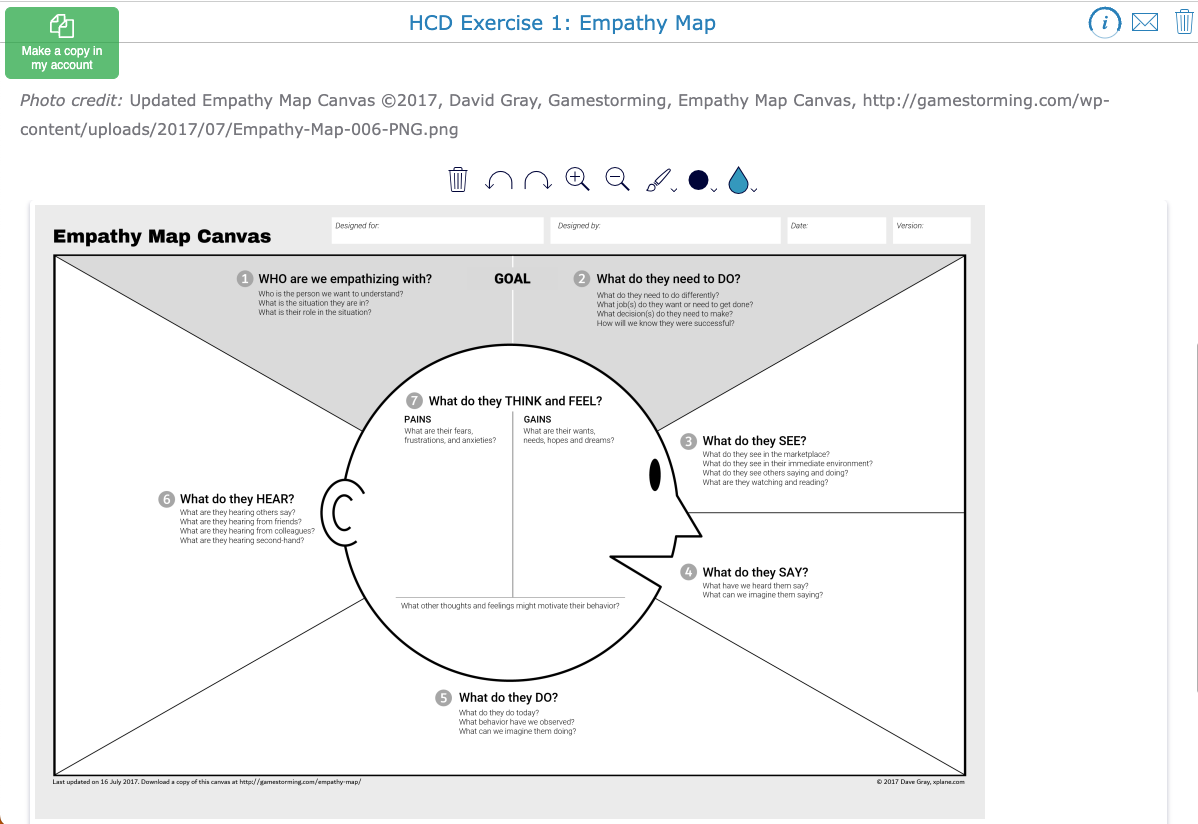
 Journey Mapping is used to visualize the positive and negative experiences a person goes through in order to accomplish a goal. Positive points reveal characteristics that could be replicated, whereas the identified pain points give opportunities to find counter meatures and solutions.
Journey Mapping is used to visualize the positive and negative experiences a person goes through in order to accomplish a goal. Positive points reveal characteristics that could be replicated, whereas the identified pain points give opportunities to find counter meatures and solutions.
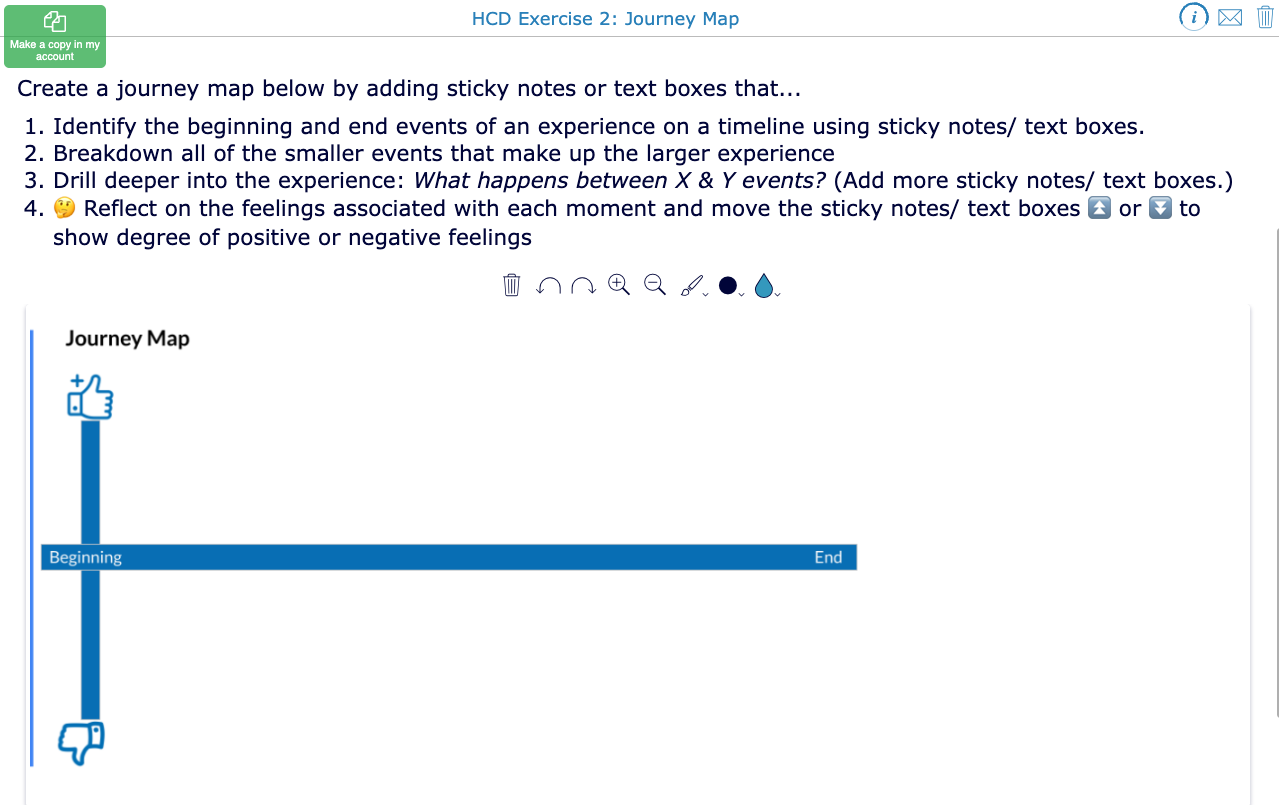
 The 5 Whys exercise seeks to identify the root cause of a problem or issue by asking “why” repeatedly and originated in the Toyota production system.
The 5 Whys exercise seeks to identify the root cause of a problem or issue by asking “why” repeatedly and originated in the Toyota production system.
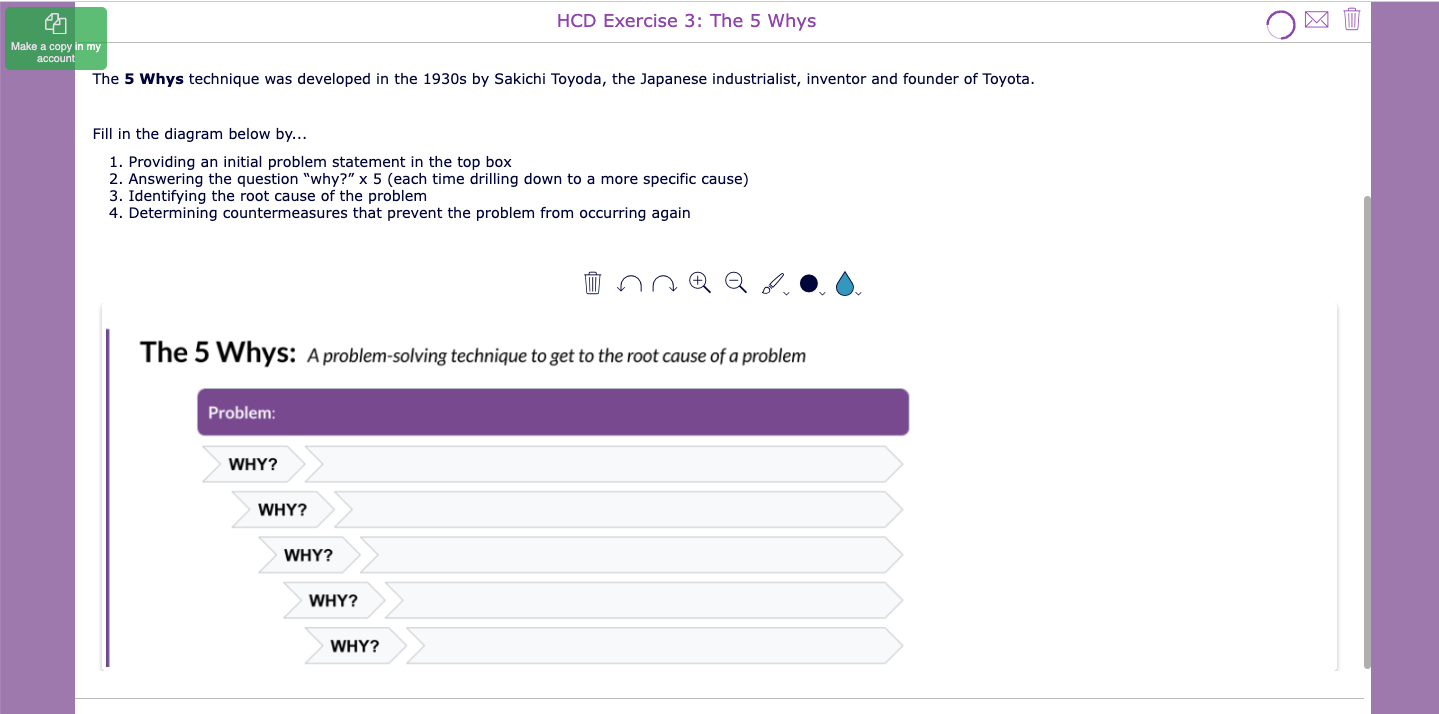
 Abstract Laddering is a tool for uncovering the deeper layers of meaning and motivation associated with a topic. It involves a structured series of questions that encourage participants to ladder up from concrete responses to more abstract and foundational values and beliefs.
Abstract Laddering is a tool for uncovering the deeper layers of meaning and motivation associated with a topic. It involves a structured series of questions that encourage participants to ladder up from concrete responses to more abstract and foundational values and beliefs.
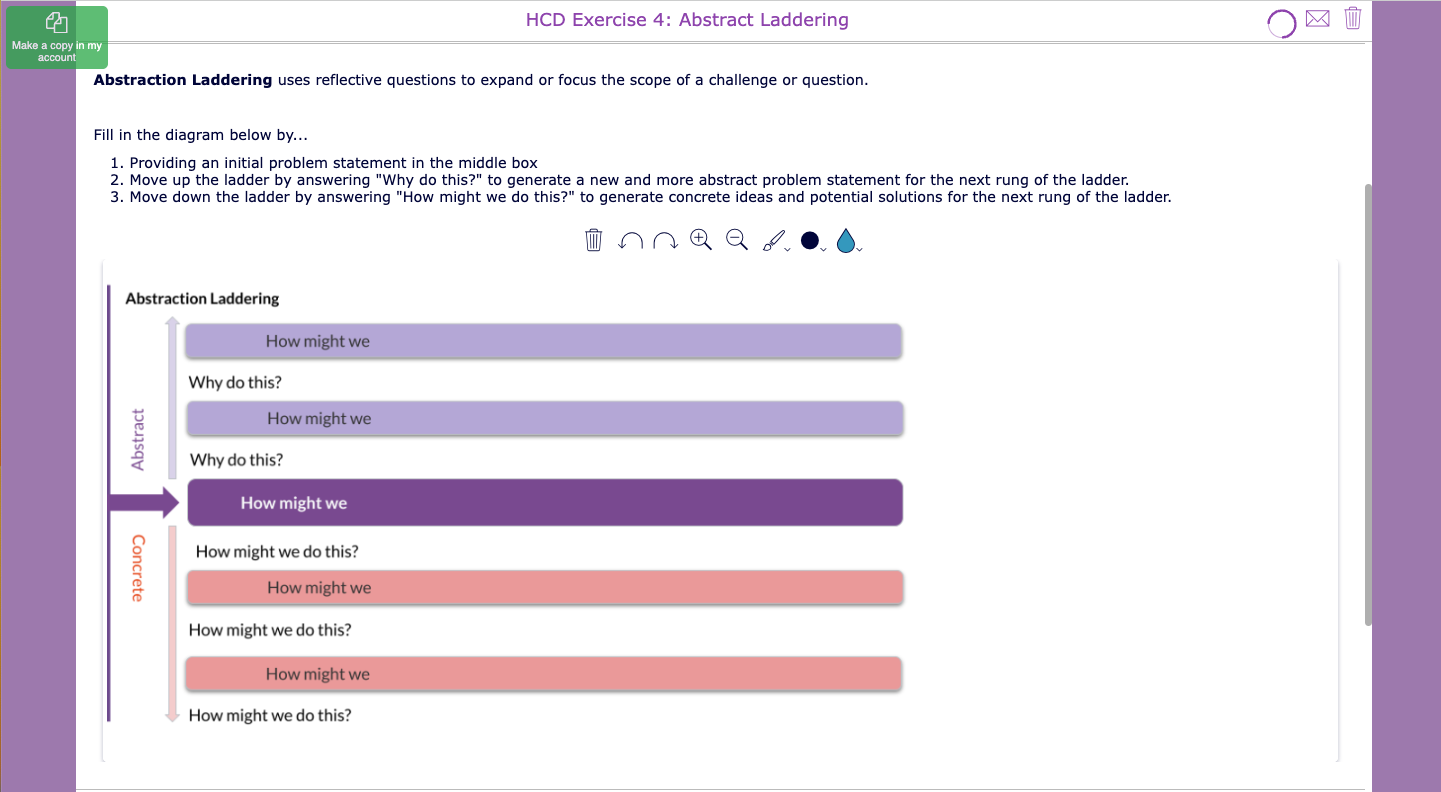
 The Creative Matrix encourages participants in this exercise to explore a wide range of ideas by considering various combinations of elements to encourage cross pollination of ideas.
The Creative Matrix encourages participants in this exercise to explore a wide range of ideas by considering various combinations of elements to encourage cross pollination of ideas.
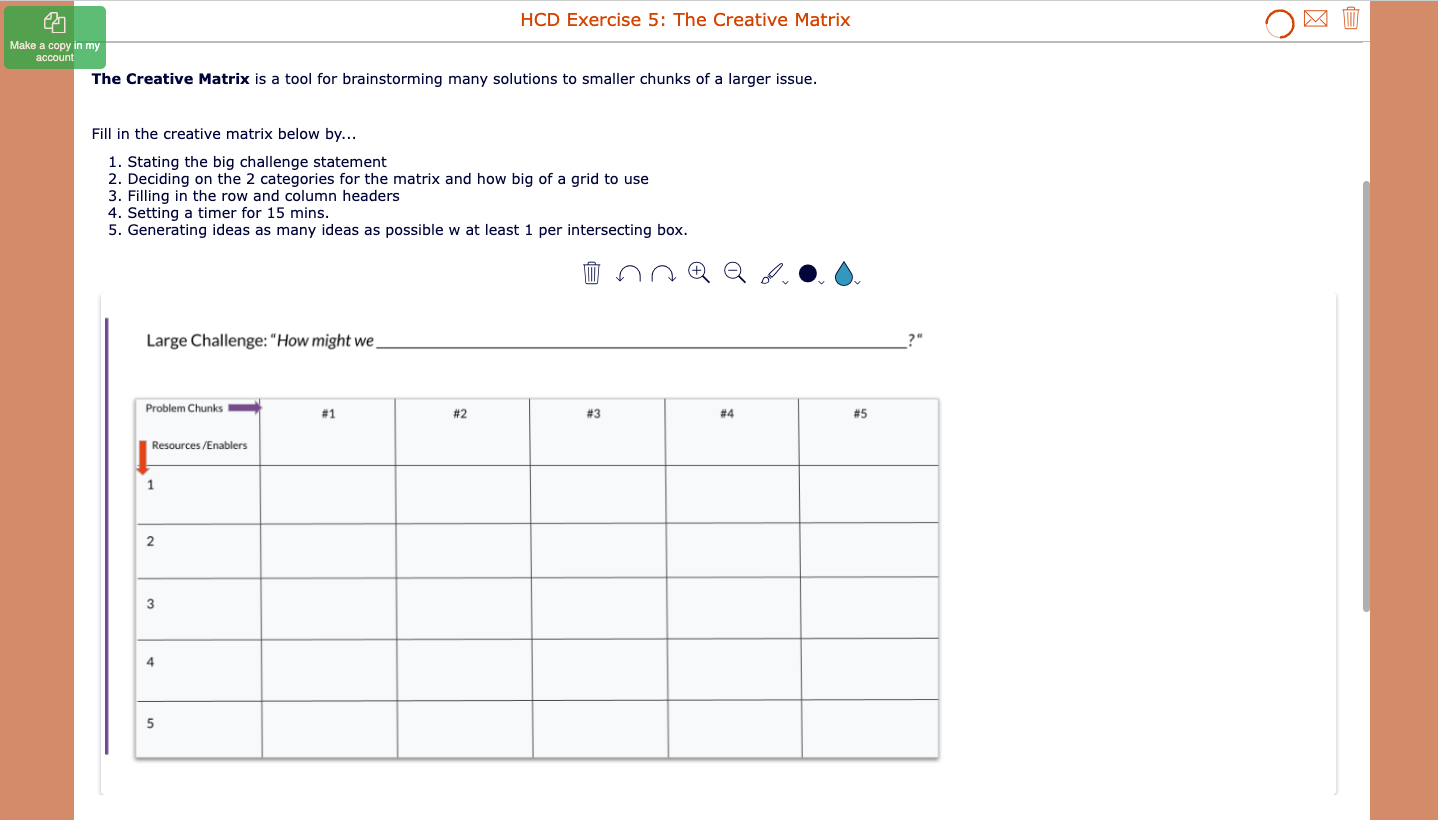
 The Lotus Blossom exercise promotes divergent thinking by encouraging participants to think both expansively and systematically to generate a widge range of ideas–64 in total!
The Lotus Blossom exercise promotes divergent thinking by encouraging participants to think both expansively and systematically to generate a widge range of ideas–64 in total! 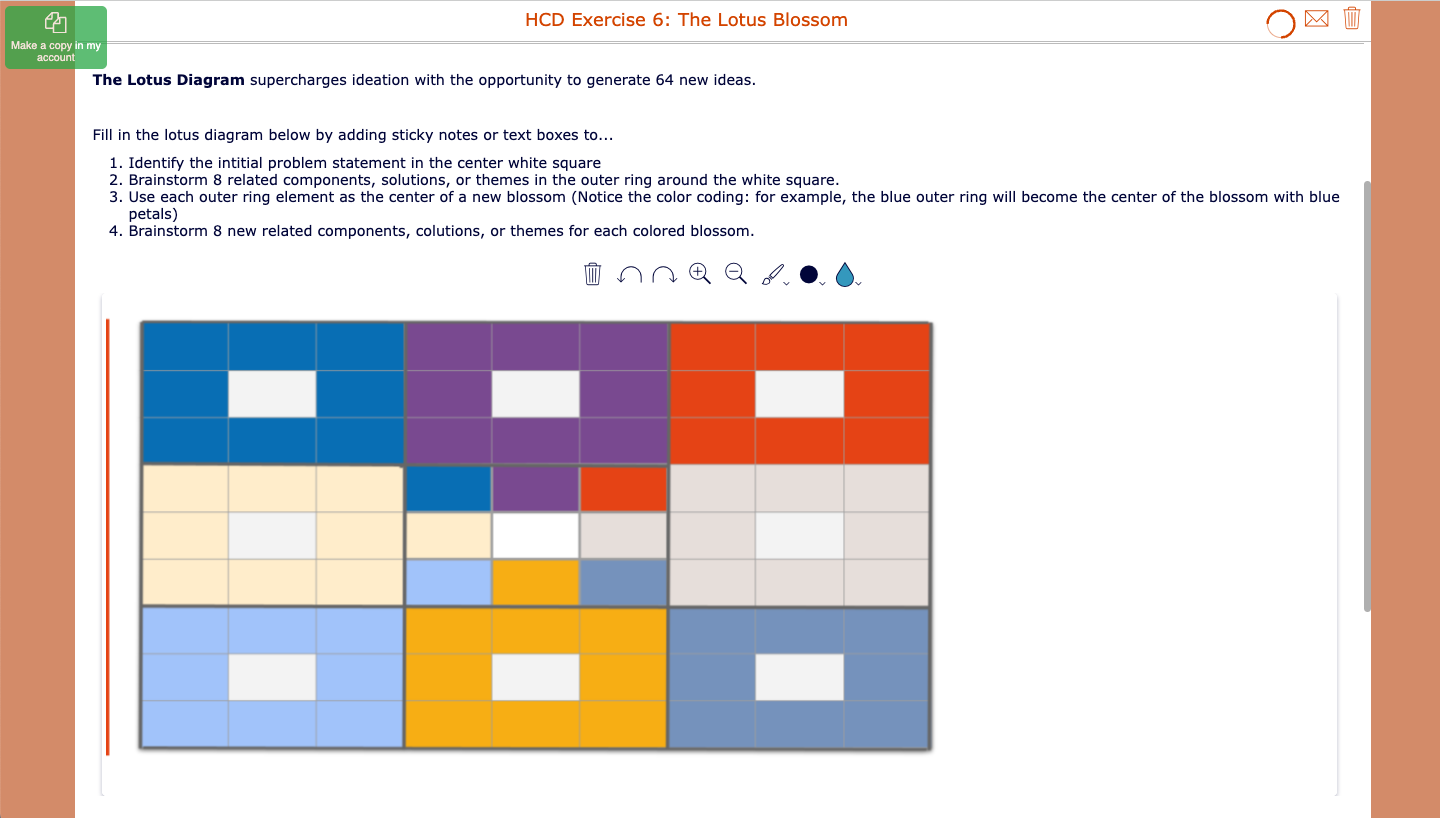
Wrap Up
Human-centered design (HCD) and design thinking are not just buzzwords in education; they are transformative tools. They empower teachers to innovate and collaborate, infusing creativity into education. Through SCAMPER and other exercises, educators can create dynamic, user-centered learning environments. So, embrace these methods, for the future of education is in your hands, shaped by empathy, creativity, and a passion for making a difference.
Want to learn more about creating engaging lesson activities with BookWidgets?
✔️ Follow BookWidgets on X / Twitter and LinkedIn and join our teacher community on Facebook!
✔️ And, be sure to connect with me, too, on X / Twitter, Facebook, and LinkedIn! 👋
